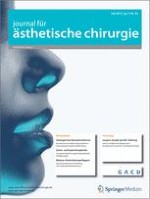Erschienen in:

01.08.2014 | Leitthema
Augmentation des Nasenrückens mit Knorpelschrot-Fibrinkleber
verfasst von:
PD Dr. A.-J. Tasman, P.-A. Diener, R. Litschel
Erschienen in:
Journal für Ästhetische Chirurgie
|
Ausgabe 3/2014
Einloggen, um Zugang zu erhalten
Zusammenfassung
Hintergrund
Die optimale Methode für die Augmentation des Nasenrückens wird aufgrund charakteristischer Vor- und Nachteile von alloplastischen Materialien und autologen Geweben weiterhin kontrovers diskutiert. Diese Übersicht beleuchtet eine Variante der Verwendung von autologem Knorpelschrot.
Wissensstand
In der westlichen Welt hat sich zunehmend die Verwendung von autologen Geweben, vor allem Knorpelschrot in einer Faszienhülle („diced cartilage fascia graft“) als Goldstandard durchgesetzt. Diese Übersicht beleuchtet unterschiedliche Augmentationstechniken und beschreibt eine Modifikation eines Knorpelschrottransplantats unter Verwendung von Fibrinkleber im Detail. Bei dieser Technik wird der Knorpel mit thrombinhaltiger Lösung imprägniert, in die gewünschte Form gebracht und anschließend mit fibrinogenhaltiger Lösung gebunden. Diese Technik erweitert das Spektrum der möglichen Transplantatformen wesentlich. Die Anwendung seit mehr als fünf Jahren sowie eine morphometrische Studie mit einem 15-monatigen Follow-up belegen die langfristige Stabilität der Transplantate.
Schlussfolgerung
Die Verwendung von autologen Geweben für die Nasenaugmentation entspricht den Wünschen der Mehrzahl der Patienten und Operateure. Das Knorpelschrot-Fibrinkleber-Transplantat hat sich als Ergänzung des rhinochirurgischen Repertoires bewährt.